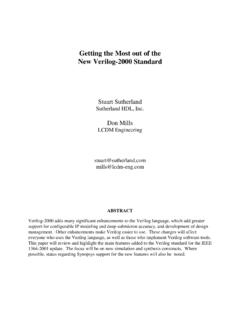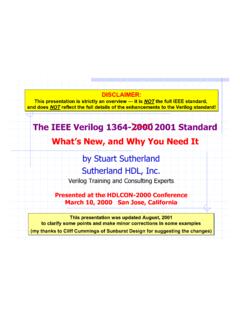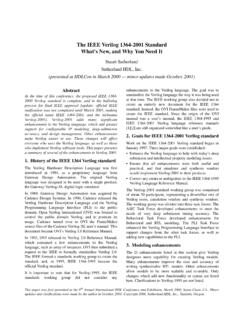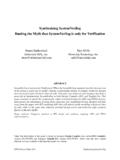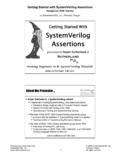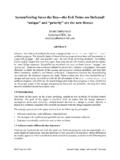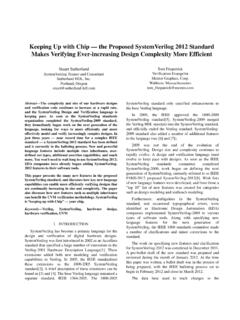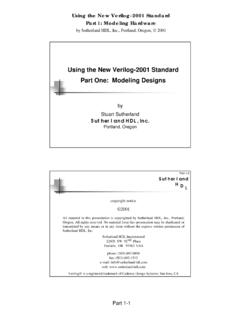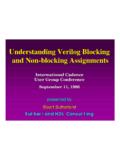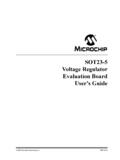Transcription of Using PLI 2.0 (VPI) with VCS (Yes, it really works!)
1 Using PLI (VPI) with VCS. (Yes, it really works !). Stuart Sutherland Sutherland HDL, Inc., Portland, Oregon ABSTRACT. The verilog PLI VPI library, often referred to as PLI , is the latest generation of the verilog PLI standard. The VPI library has a number of advantages over the older TF and ACC libraries (often collectively referred to as PLI ). The VPI library has been part of the IEEE 1364 Ver- ilog standard since 1995, but the VCS simulator has only just begun to support the VPI library with version , which is projected to be released early in 2002. This paper presents why it is desirable to use the VPI library, and how well the library is supported in VCS. The goal of the paper is to answer the question: Are there compelling reasons to use PLI in your future PLI. applications? . What are PLI and PLI . The PLI has been an integral part of the verilog language since 1985, and has been a major con- tributor to the success of verilog .
2 There have been a number of versions of the PLI in its 17-year history. 1985: The TF library. The original verilog PLI was designed to read and write the arguments of a system task. For the most part, this first generation of the PLI could not see the internals of a simulation data structure; it could only see the information passed in as system task arguments. This first generation of the PLI is a library of C functions which mostly begin with the letters tf_ (for task/function ). Hence, the library is often referred to as the TF library. In most Ver- ilog simulators, the TF library is defined in a file called Until version , however, VCS placed the library in a file called VCS now uses the standard file. 1988: The ACC library. A second generation of the PLI was created to supplement and extend the capability of the TF library. This second library is defined in a different C file, called All the routines in this library begin with the letters acc_ , which stands for access.
3 The ACC library was developed specifically at the request of ASIC vendors to do delay calculation, power analysis and other types of analysis involving the cells that make up an ASIC. netlist. The ACC library provides access into the simulation for structural designs (netlists). The ability to access the structural level of a design has made the ACC library very valuable for a wide variety of other types of applications as well. Waveform displays such as VirSim and other graph- ical design debug utilities often use the ACC library. A primary limitation of the ACC library, however, is that it can only access the structural level of verilog models. The ACC library cannot access RTL models, memory arrays and many other types of objects that make up a large part of many verilog HDL models. Another drawback of the ACC library is its ad-hoc evolution. Much of the library of C functions were added after the orig- inal release in 1988.
4 These additional routines were added a little here and a little there, with no guiding specification to ensure consistency in syntax and semantics. As a result, the ACC library is full of inconsistencies, redundancies and poorly defined behavior. It is awkward to learn and difficult for simulation vendors to implement. The ACC library behaves differently in every Ver- ilog simulator. 1990: The OVI PLI standard. When Gateway Design Automation/Cadence released the verilog language and PLI to the public domain, the users forum Open verilog International (OVI). labeled the combined TF/ACC libraries as PLI . This term was strictly a label PLI did not add any new features or capabilities to the verilog PLI. 1993: The OVI PLI standard. OVI decided to completely replace the TF and ACC librar- ies with a new library, that eliminated the redundancies and limitations of the old libraries.
5 OVI. called the new library PLI . This new library combined all the functionality of the 200+ rou- tines in the TF and ACC libraries into a single library of about 25 routines. The syntax of these routines were simple and well defined. PLI overcame many, if not all, of the weaknesses and drawbacks of the ACC library. OVI intended to totally eliminate the old TF and ACC libraries, and therefore deliberately made PLI so that it was not backward compatible. Indeed, OVI's PLI called its library ACC, and used many of the same function names and constant names as the older ACC library, but with dif- SNUG San Jose 2002 2 Using PLI (VPI) with VCS / Stuart Sutherland ferent functionality and values. Because PLI was not backward compatible, the hundreds of existing PLI applications could not be used together with a PLI application. Therefore, no simulators ever completed implementing the OVI version of the PLI standard.
6 The original OVI PLI never saw the light of day. 1995: The IEEE 1364-1995 standard1 and the VPI library. In 1995, the IEEE standardized both the verilog HDL and PLI the way it stood in 1993. No enhancements were considered for 1364-1995. For the PLI, the IEEE chose to standardize both PLI and The former, to pre- serve backward compatibility. The latter, because it really was a much better procedural interface. To allow both the old PLI and the incompatible PLI standards to be used at the same time, the IEEE rewrote the PLI so that it was backward compatible. As part of that process, the PLI. routines were renamed to VPI (for verilog Procedural Interface ). Note: In the IEEE standard, the terms PLI and PLI do not exist. There is one PLI, with three libraries, TF, ACC and VPI. 2001: The IEEE 1364-2001 standard2. The IEEE spent three years defining a major set of enhancements to the verilog standard.
7 These enhancements were ratified early in 2001. The new verilog -2001 standard adds a number of powerful enhancements to the verilog HDL, including: multi-dimensional arrays, re-entrant tasks, recursive functions, configurations, attributes (which can replace those annoying synthesis pragmas hidden in comments), and several dozen other use- ful and important features. For more details on these features, refer to the SNUG San Jose 2001. Conference paper, Getting the Most out of IEEE 1364-2000 verilog Standard 3. Why use the VPI library? To understand the advantages gained by Using the VPI library, we must first look at the strengths and weaknesses of the older TF and ACC libraries. Strengths and weaknesses of the TF library The TF library can only access the arguments of a system task or function. Due to this limited access, simulators can predict at compile time exactly what information a PLI application will access.
8 This allows simulators to highly optimize the simulation data structure. VCS takes full advantage of this, and achieves its best simulation performance when only the TF library is used. However, the TF library cannot traverse design hierarchy, analyze design structure, modify delays, or access RTL code. This greatly limits the types of PLI applications that can be written with the TF library. Originally, the TF library contained just a few C functions. Over a number of years, however, the library evolved until it grew to have more than 110 C functions. This growth occurred with no specification to guide the evolution. As a result, the library is full of inconsisten- cies and redundancies. The TF library also has a great number of problems with portability to dif- ferent simulators and different operating systems. Hence PLI applications do not work the same way on all simulators.
9 In part, this portability problem stems from the fact that the TF library was originally designed to work with just the Cadence verilog -XL simulator, in the days of DEC PDP- 11 computers. The TF library does not support many of the new constructs added in the IEEE. 1364-2001 standard. SNUG San Jose 2002 3 Using PLI (VPI) with VCS / Stuart Sutherland Strengths and weaknesses of the ACC library The ACC library is an extension to the TF library. It provides access to structural objects within a simulation data structure. Structural objects include module instances, primitive instances, delays, net declarations, and variable declarations. The access to structural objects is achieved Using rou- tines which can search for objects. This overcomes the primary limitation of the TF library, which requires objects to be listed as system task/function arguments.
10 However, the ACC library suffers from many of the same problems as the TF library. There are well over 100 C functions, with inconsistent syntax and semantics. The specification and documentation of the ACC library rou- tines were grossly lacking when the library was first placed in the public domain. This has led to differences in the way the ACC routines work on different simulators. The ACC library can arbitrarily access any structural object anywhere within the simulation data structure. This provides the capabilities needed for SDF back annotation, power analysis, gate- level logic flow tracing, waveform displays, and a wide variety of commercial and in-house PLI. applications. But, the ACC library is limited to only accessing structural (netlist) based designs. The ACC library cannot access all types of objects that make up the typical verilog design.
